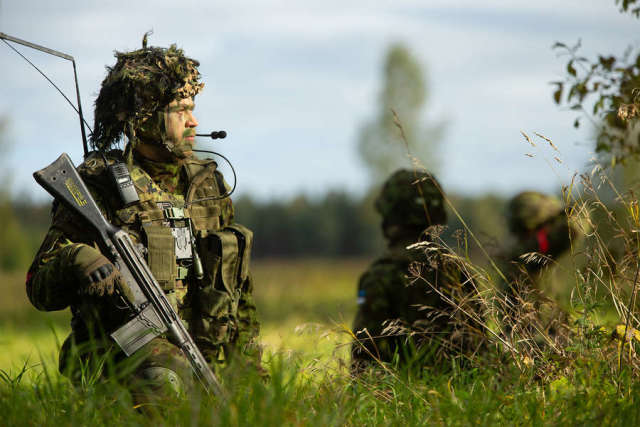Military expert Belousov explained the reason for NATO's activity around Kaliningrad
A whole series of military exercises of NATO countries has started near the Kaliningrad region. They take place on the territory of Estonia, Latvia, Lithuania, and other countries. At the same time, not defensive, but offensive actions are being worked out. At the same time, against the background of Sweden and Finland joining NATO, Poland announced the need to "demilitarize" Kaliningrad. "Newspaper.Ru" figured out why the North Atlantic Alliance needed it.
Former Polish Deputy Defense Minister Romuald Sheremetyev said that after Finland and Sweden join NATO, the alliance needs to take care of the "demilitarization" of the Kaliningrad region of Russia. In addition, in his opinion, the city of Kaliningrad should be renamed.
"We must, however, ask Kaliningrad to stop naming itself after the criminal Kalinin, who is jointly and severally responsible for the murder in Katyn. Secondly, it is high time to demilitarize Kaliningrad. NATO cannot sit on a powder keg," Sheremetyevo said in an interview with the Polish newspaper Do Rzeczy.
The governor of the Kaliningrad region, Anton Alikhanov, responded by saying that the proposal for "demilitarization" is "a classic example of Russophobia."
At the same time, a whole series of NATO exercises began near the region. So, on May 16, the exercises Sill-2022 ("Hedgehog-2022") started in Estonia. Latvia, in turn, organized Namejs exercises. Separately, as part of the Defender Europe exercises, US Marines will work out interaction with the armies of the Baltic countries, and the headquarters of the Northern Division of NATO announced the Knight Legion exercises.
"All these maneuvers are aimed at working out an action plan for the seizure or, at least, a military blockade of the Kaliningrad region," said Sergei Belousov, a member of the Board of Military Experts.
According to Belousov, special concerns among NATO countries are caused by the Iskander complexes, which were officially deployed here in 2016.
"There is an important aspect here. The claimed range of the Iskander is 500 km. The distance to Berlin from Kaliningrad in a straight line is 525 km. That is, it can only hit the suburbs. London is 1400 km away as the crow flies. It doesn't seem to get it.
The 500 km frame was provided for by the Treaty on the Elimination of Intermediate-Range and Shorter-Range Missiles (INF), but in 2019 the United States withdrew from the treaty, then Russia withdrew, which means that no one prevents us from using the full potential of 9M729. Western analysts estimate the range of this missile at 2,000 km, and even 5,000 km. In this case, Iskander can cover any point in Europe from Kaliningrad. This, of course, scares them. They demand to remove the Iskanders, they are building up their forces nearby," Belousov said.
NATO combat battalion groups have been established in each of the Baltic republics and in Poland. Their number is constantly growing. Estonia and Latvia are "supervised" by the UK, Lithuania by Germany, Poland by the USA. Support is also provided by other member countries of the alliance with the outright dominance of American military personnel.
"Defense Minister Shoigu is aware of all NATO movements in the Baltic States and Eastern Europe," he told the newspaper.Ru" a high-ranking source in the Russian military department. - The situation is being monitored, there are appropriate response measures. It's not like we're facing external threats in Kaliningrad right now. Our military grouping was being systematically built up there, new formations were being created, and modern weapons were being supplied. The Baltic Fleet is also fully involved there, and this is a serious component of the entire complex of defensive measures. Kaliningrad has been and remains Russia's key position in the Baltic."
At the same time, the general disposition of forces in this region is clearly not in favor of the alliance, Sergei Belousov believes.
"The Russian-Polish border in the Kaliningrad region is almost 200 km, most of which are impassable swampy and wooded areas. Accordingly, it is much easier to defend them. At the same time, Russia has a hypothetical option of an emergency redeployment of its forces and means, including the tank army, along the so-called Suvalkovsky corridor. This is a piece of terrain where Poland and Lithuania have a common border with a length of about 65 kilometers, and Belarus is adjacent to it," the expert said.
In the event of hostilities, the "corridor" can connect the main territory of Russia with the Kaliningrad region. The American analytical center RAND has compiled a simulation model that shows what the balance of power can be during a conflict.
"All the talks and plans about an armed confrontation between NATO and Russia, about the possible seizure of the Kaliningrad region, are primarily aimed at maintaining the morale of Poland and the Baltic states," he told the newspaper.Ru" Belarusian political scientist Alexander Zimovsky. - Warsaw, Vilnius, Riga and Tallinn show their readiness to protect them from imaginary aggression from Russia. The Americans have brought their military forces there, they show readiness for joint protection in every possible way, but they will not really use anything in case of danger and will immediately evacuate. They perfectly see the futility of the blockade attempt."
Victor Sokirko

